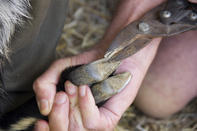Goats have a fast metabolism and are constantly on the move to browse and eat. Hoof disease and neglected hooves make walking and browsing for food difficult and painful.

When goats’ hooves are overgrown, it can lead to hoof rot (on the sole and the wall of the hoof) and hoof scald, which occurs between the hoof ‘toes’. Hooves should be trimmed regularly (up to four times per year) to keep their normal shape - have a look at a very young kid's hoof as a reference for the perfect shape.
How to Treat Hoof Scald
Hoof scald mainly occurs in wet conditions when the microorganism Fusobacterium necrophorum causes inflammation between the ‘toes’. The skin between the ‘toes’ can be raw and moist with a pink colour and is sensitive when touched.
If not treated, the goat can become permanently infected. Squirt a 10% solution of copper sulfate or zinc sulfate between the ‘toes’. A 7% solution of iodine can also be used. If goats are grazing on pastures, treat them after the dew is gone or keep them in a dry environment for 24 hours after treatment.
The solution will dry on the hooves and feet and will be more effective. When a substantial number of animals in a herd is affected, use a footbath of a zinc or copper sulfate solution to allow absorption into the hoof wall. Boer goats are more susceptible to hoof scald.
How to Treat Foot Rot
Foot rot is a contagious disease of the hooves in goats and sheep and is caused by the microorganisms Dichelobacter nodosus and Fusobacterium necrophorum. Dichelobacter nodosus, which are found in contaminated soil.
The first signs of hoof rot are goats limping, holding limbs in the air and grazing on knees. Animals may be reluctant to walk and the hooves may be foul-smelling and exude a pus. Treatment for foot rot involves trimming of the hoof and removing all infected sole that has separated from the underlying tissues.
After trimming, affected animals should stand for at least 5 minutes with all feet in a 10% solution of copper or zinc sulfate. This can be repeated once a week for four weeks. Animals that do not heal, should be culled. Contamination can occur when an infected animal is added to the herd and when foot rot microorganisms are carried in soil on visitors' shoes.
How to Trim Goat Hooves

The best time to trim hooves is after it has rained, when the hooves are softer and easier to cut. You will need an assistant to hold the goat in a comfortable sitting position while you trim its hooves.
Using the tip of the hoof shears, first remove dirt and mud from the hoof. After which, determine that the sole of the hoof is level before starting to cut any of the wall of the hoof away. Begin by trimming off the point of the hoof of one claw. Then trim the outer side of the hoof.
If the hoof wall is overgrown, gently pry it open and cut it off with small slices. Don't rush this process by taking big cuts as it can cause the hoof to bleed. Gradually trim the hooves down until you can see the white line of new hoof growth. Stop trimming when the sole appears pinkish and all hoof rot has been removed.
Finally, trim the inner side of the hoof - between the hooves (‘toes’) where the heels meet. Take care here as the heel is softer than any other part of the hoof. Hoof rot is normally found near the tip of the toe and along the hoof walls; it seldom occurs at the heel.
By Marinda Louw